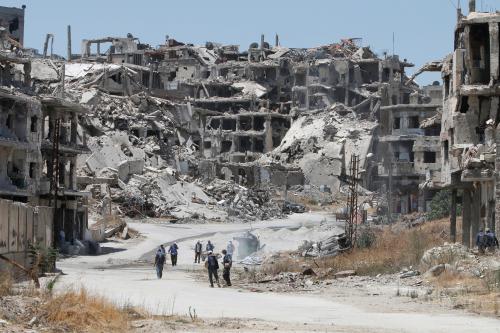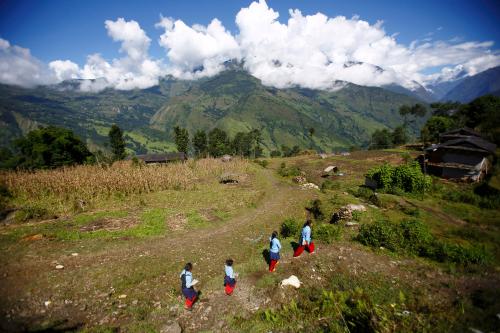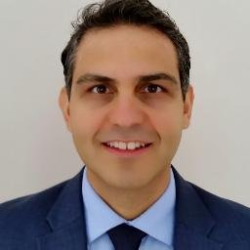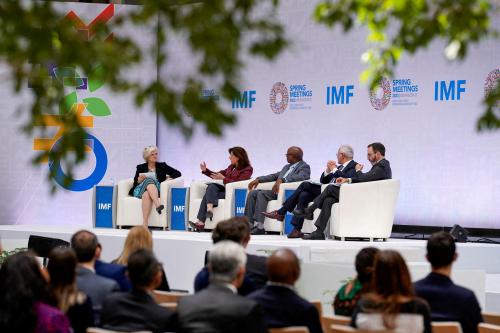Fragile states are at the center of today’s global development crisis. By 2030, an estimated 80 percent of the world’s extreme poor will live in these perilous places. While international actors have broadened their focus to cover fragility, conflict, and violence, this has not come with high-level political calls to recognize “fragility as the new development frontier.” Fragility merits top billing and should encompass security reform, peace building, poverty reduction, environment, humanitarian assistance, and equity.
At a Brookings and World Vision roundtable earlier this month, experts from multilateral institutions, the U.S. government, think tanks, universities, and nongovernmental organizations discussed this urgent challenge.
The following are our key takeaways.
Framing fragility
The OECD’s fragility framework identifies 56 countries as fragile. It defines fragility as “the combination of exposure to risk and insufficient coping capacity of the state, system, and/or communities to manage, absorb, or mitigate those risks.” It differentiates the levels and types of fragility across five dimensions: political, societal, economic, environmental, and security. This allows for the inclusion of Bangladesh, Kenya, and Cambodia alongside the far more fragile South Sudan, Somalia, Yemen, and Syria. While still experimental, the OECD framework is broad enough to encompass countries which, while not necessarily low-income or conflict-affected, are contending with high levels of political, economic, societal, environmental, and economic fragility.
Toward a new consensus
The increasing demands posed by fragile states have cast light on the inadequacies of the international aid system to respond. The current system delivers a patchwork of disparate development projects, emergency services that last decades, and scattered technical advice in the face of systemic breakdowns in political legitimacy, markets, and service delivery, and in extreme cases, state failure.
To realize the internationally agreed Sustainable Development Goals (SDGs) and to “leave no one behind,” the international aid community must either forge consensus on systemic reforms to meet the challenges of fragile states, or resign itself to the dysfunctional status quo.
A new political consensus for putting fragility at the center of the global development agenda should focus at the outset on the three following points.
- Mission
Fragile states must aim to become resilient nations that can deliver development outcomes while continuously adapting to challenges and gradually overcoming the causes of fragility. Getting there requires focusing on three objectives: eradicating extreme poverty and promoting inclusive development and growth; identifying and dealing with risks and crisis from conflict, disaster, and destitution; and addressing the underlying causes of fragility stemming from broken social contracts, weak institutions, and societal divisions. Delivering on this in the face of weak institutions, entrenched political economies, and legacies of mistrust and exclusion is enormously challenging. To succeed, donors and other international partners must overhaul the aid system in line with promising new directions for adaptive development, fostering social capital, technological innovation, scaling operations, and improved country coordination. - Moving away from projects and stovepiped technical support
There must be new terms of development cooperation that appreciate the magnitude of the challenges and commit to new ways of working. It requires a focus on structural challenges and building political settlements, social contracts, markets, and public administration. This does not mean international partners should play a directive role akin to the U.N.-run transitional administrations in Kosovo and Timor-Leste. Rather, they should encourage fragile governments to experiment, iterate, and adapt to complex challenges in line with emerging practice around problem-driven iterative adaptation. The perverse result of aid conditionality has too often been institutions that look Western in form but are dysfunctional because they lack the advanced bureaucratic operating systems required for success—a condition called “isomorphic mimicry.”Instead, a “protected space” must be cultivated between governments and partners to encourage adaptation, accountability, and results without fear of violating rigid rules on corruption and compliance. The World Development Report 2017: Governance and the Law likens donor aid that hinders governments and societies from finding their own adaptive methods to a “curse.” The New Deal principle of using country systems as much as possible has often been a bridge too far for wary donors. The ultimate realization of this principle will require a significant shift in development cooperation toward function over form, allowing space for experimentation, failure, and adaptation. - Understanding context and complexity
The dominant focus of international partners on sectoral advice and projects has rendered invisible the complexity and contextual variations of fragile states. A shift toward more systemic reforms will require efforts to make visible how complex systems behave and interact, along with a better understanding of the role of institutions in setting rules and governing behavior. Carrying out political economy assessments are critical for understanding patterns of exclusion, patronage, and clientelism. These should be incorporated into broader resilience assessments that identify the intensity and interaction of complex risks.Resilience assessments should map available capacities in the formal and informal sectors, with an outsized role for social capital. The standard approach of trying to build human capital and infrastructure is necessary but not sufficient. It is critical to focus on strengthening social capital through efforts to strengthen norms, networks, and relationships within and between communities, as well as between communities and formal institutions. Social capital widens the pool of available capacities to deliver services, deal with risk and shocks, and helps address root causes by changing patterns of dialogue, cooperation, and inclusion.Understanding the composition, function, and incentives of public administration in fragile states is vital and should be a special focus of the World Bank’s new “Bureaucracy Lab,” an initiative to better understand the world’s public officials. Importantly, externally recommended reforms should be mindful of political economy factors. For example, when removing thousands of “ghost” employees from a fragile state’s bureaucracy, the possible consequences merit consideration. Were ghost employees a simple case of malfeasance or the way a political leader rewarded an influential patronage network or co-opted opponents to help stabilize the country? Technological advances, including mobile telephones, can advance the work of making contexts and complexity visible via crowdsourcing, satellite imagery, and big data. These technologies help to gather data and analyze trends on extreme poverty, disaster and conflict, government performance, and public perceptions. Critically, these data and analysis must work with adaptive development approaches for real-time feedback, learning, and iteration instead of as snapshots for fixed project designs, log frames, and annual learning, and evaluation. Technological innovation, like bureaucratic reforms, must be politically sensitive and contribute to informed policy to support reforms and do no harm.
Adopt scaling-up approaches
The perceived wisdom is to keep projects in fragile states small and manageable and avoid trying to work at scale because of the higher risks involved. This makes sense for an aid system that largely works through short-term, one-off projects. Yet, scaling is arguably less risky than a project-based approach. Done well, scaling requires greater investments in understanding contexts, mobilizing and blending resources, securing political authorization and popular support, and building the capacities of the private sector or government to deliver. The Basic Package of Health Services for Afghanistan and the Afghanistan National Solidarity Program are leading examples of successful scaling amidst fragility.
Applying systematic methods for scaling can provide broader operational, political, economic, and social spaces for collaboration and adaptive development in ways that transcend the projects approach and which build social capital, meet widespread needs, and build resilience.
Establish country mechanisms to guide implementation and solve collective action problems
Country-led institutional frameworks and coordination mechanisms between the government and partners are vital. A significant barrier to the New Deal’s success is the lack of country coordination mechanisms to rally partners, mobilize resources, and move forward on a compact and “one plan.” Somalia’s Compact Coordination Platform allowed the country to create a center of gravity for the government and partners to plan, troubleshoot, and implement together. Yet, unlike the humanitarian cluster system, a much-scrutinized operational doctrine, few lessons have been gleaned from past government-led coordination mechanisms for post-crisis development.
Members of the g7+ countries have extensive experience with these mechanisms that should be mined for purposes of learning, conceptual refinement, and contextual adaptation. These include mechanisms for post-crisis transition in Afghanistan, Haiti, South Sudan, Timor-Leste, and Liberia. Sierra Leone is currently experimenting with an ambitious institutional framework and coordinating mechanism for the SDGs and the New Deal.
The U.N. secretary-general’s report for the World Humanitarian Summit called for a country mechanism based on resilience principles. It entails detailed risk mapping to inform a comprehensive problem statement covering peace and security, the environment, and relief and development. From there, it organizes diverse partners in accordance with which capacities are best suited to address particular risks and deliver specific results. This proposal is bold and worth pursuing.
Committing to better designed- and managed- country coordination mechanisms and adaptive, iterative approaches to supporting fragile states would make for a step-change in achieving mission critical tasks in fragile contexts.
Next steps
A unique window exists to put fragility at the center of the global development agenda. The U.N. secretary-general is reforming the U.N.’s peace and security architecture and the U.N. development-system. In terms of the latter, an increasing focus on fragile contexts is already apparent through the work of United Nations Development Program, International Labor Organization, World Food Program, Food and Agriculture Organization, and International Fund for Agricultural Development. The World Humanitarian Summit committed to stronger links between the U.N. humanitarian entities and development agencies, a promise that will carry over into U.N. Secretary General António Guterres’ discussions of “cross-pillar” collaboration between the security, development, and human rights pillars.
The World Bank has expanded its fragility department and committed over half of the funds from the International Development Association, the World Bank’s fund for the poorest, to fragile situations. The OECD Development Assistance Committee has a central focus on fragility, supporting the International Dialogue on Peacebuilding and Statebuilding and the g7+ group of fragile states. The Global Funds and regional banks, especially the African Development Bank, Asian Development Bank, and Gavi, the Vaccine Alliance have increased their focus and funding commitments to fragile contexts. China, the EU, and the U.S. are all committed in principle to helping fragile states succeed, though their approaches are disparate.
The World Economic Forum has taken interest in fragile states over the past several years, convening a global council to explore public-private partnerships in these contexts. USAID has public-private partnerships in the majority of fragile states where it operates, with 10 or more public-private partnerships in half of these countries.
As these various institutions and partners work to advance the SDGs, there must be a collective recognition that fragile states are essential to reaching the finish line. The U.N. and World Bank, encouraged by member states, should lead a new consensus aimed at re-envisioning the international development system if we are to overcome the last mile toward ending extreme poverty.








Commentary
State fragility is key to reaching the last mile in ending poverty
November 21, 2017